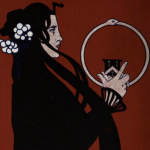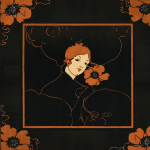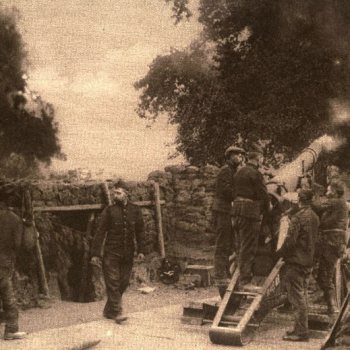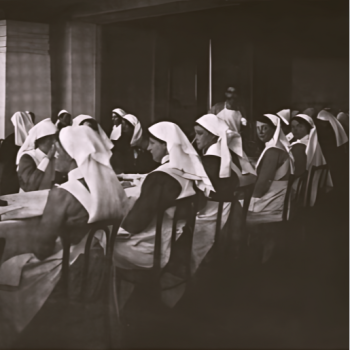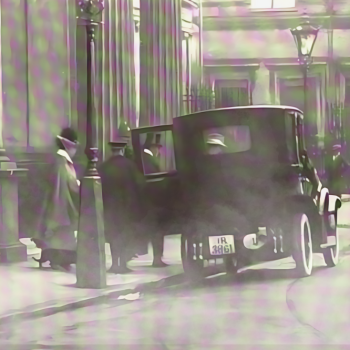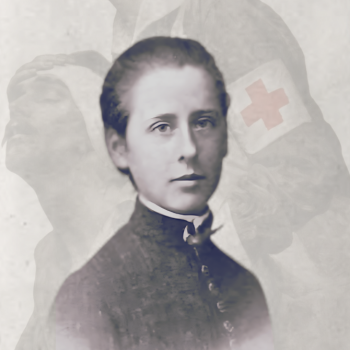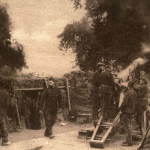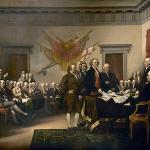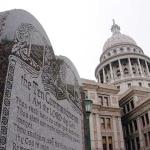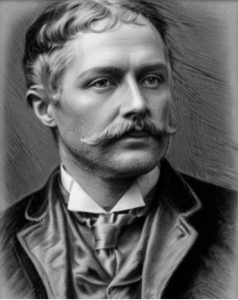
Henry B. Foulke.[1]
Henry Bellerjeau Foulke (1856-1938) was a well-known Philadelphia real estate agent of 305 South Eleventh Street, who joined the Krishna Branch T.S. (Philadelphia) in December 1887.[2] He was a pronounced blonde, “handsome, sturdy, mannish-looking,” and tall.[3] Those who knew him in Philadelphia recalled the “admiration which his unusually attractive figure never failed to attract.”[4] Of his personal life, Foulke states that he “supported seven people for years.”[5] The eldest son of Richard and Mary Foulke (née Bellerjeau,) Foulke had eight siblings (six sisters and two brothers,) so perhaps his statement is in reference to his family. He had risen from poverty, it was said, “for his forefather could afford his son no advantages.” By the closing decade of the nineteenth century, however, he was a wealthy conveyancer “living luxuriously in the Quaker City.”[6] (As an outward display of wealth, he wore a diamond ring on his right thumb.)[7] In his capacity as a real estate agent, Foulke was connected with the Wagner Free Institute in the mid-1880s.[8] (Robert Brodhead Westbrook, one of the original members of the Theosophical Society, was also connected with this institution.)[9] An early example of his venture into mysticism was a test he conducted using spirit-writing. A letter from the ghost of Pythagoras told him that he was destined to complete an important spiritual mission.[10]
The writings of mystics of every school soon took a powerful hold on him, and he would sit for hours brooding over the world of the dead. At last he declared himself a theosophist. He organized a society and plunged into the intellectual vortex of esoteric Buddhism. His home was the home of all who sincerely or otherwise manifested an interest in the occult.[11]
It seems that one of the first Spiritualists that Foulke encountered was the medium named Ann O’Delia Diss Debar.[12] She was a woman whom Olcott described in 1888 as “both a great medium and a great swindler.”[13] Born Ann O’Delia Salomen near Harrodsburg, Kentucky around 1849, her father being a member of an old, well-respected, Kentucky family. She was a woman of many cults, and used them all to defraud, practicing her arts in cities all over the world, “and numbered among her victims some of the wisest, shrewdest, and wealthiest men.” Her love, and partner-in-crime, was an Alsatian artist named Joseph Diss Debar (who designed the state seal for West Virginia.)[14] The couple had two children, and by 1888 the family was living in the home of a wealthy, aged, New York jurist named Luther R. Marsh. It would be this case which brought her into notoriety (and resulted in her exposure of many past crimes.) Diss Debar held séances in Marsh’s home (which she called the “Temple of Youth,”) and from time to time the “spirits reproduced paintings by the hands of old masters, costly bric-a-brac and marbles.” Marsh’s bank account dwindled, and it soon became known that Marsh had deeded Diss Debar the title of his home, and made over to her property valued at $50,000. A court found her guilty, and she was sent to Blackwells Island in 1888. [15]
Foulke first emerges in Theosophical history in 1888, when Carl F. Redwitz (the first President of the Krishna T.S.,) resigned from his position, and moved to New Orleans, Louisiana.[16] Foulke was subsequently made President locum tenens of that Branch until a new President, Edward H. Sanborn, was elected.[17]
In addition to his interest in Theosophy, Foulke was an active Spiritualist, a movement which experienced something of a crisis in October 1888 when two of the Fox sisters denounced the movement they helped launch. The troubles began in May of 1888, when the Society for the Prevention of Cruelty to Children (S.P.C.C.) charged Katie Jencken [Fox] with being a “dipsomaniac” (alcoholic,) and neglecting her two boys. Katie was arrested, and her children were placed in the New York Juvenile Asylum.[18] She had good reason to believe that powerful Spiritualists, headed by Leah, the eldest of the Fox sister, had used the S.P.C.C. to persecute her, out of fear of the sisters exposing their secrets. Maggie enlisted the help of other well-connected Spiritualists to help retrieve the boys, and secure Katie’s release. (One of these allies being Isabella Beecher Hooker, sister of Henry Ward Beecher and Harriet Beecher Stowe.)[19] She then went to England, where she held séances with E.A, Cottell in the former home of Thomas Carlyle, which W.T. Stead attended and wrote about in September 1888.[20] (The Theosophist Edmund Russell also attended these séances, which he discussed with Blavatsky.)[21] On September 28, 1888, Katie and her boys left England and returned to America.[22] When they arrived on October 9, 1888, Katie learned that her sister, Maggie (Fox) Kane (widow of the Arctic explorer Elisha Kent Kane,) had announced that she intended on exposing Spiritualism “from a to izzard.”[23] This took Katie completely by surprise. Afraid that another attempt would be made to separate her from her children, Katie made arrangements for hey boys to return to England before their presence was known in New York.[24] On October 28, Maggie would expose Spiritualism at the Grand Opera House, in Brooklyn. Katie, in support of her sister, denounced Spiritualism as well.[25] Perhaps Katie was right to be afraid, for on October 13, 1888, the driver of a mysterious carriage tried to abduct her and Maggie.[26]
It was on that same day that Foulke makes an entrance in the Theosophical mythos. In the autumn of 1888, Foulke invited Govindarao Sattay to attend a séance on October 13, 1888, with a dozen men (mostly Theosophists,) and believers (more or less) in Spiritualism. The séance was held in his home on Eleventh and Walnut, and conducted by Horatio Eddy.[27] Horatio and his brother, William, held a unique honor in the history of the Theosophical Movement. It was while attending séance on the Eddy farm in Chittenden, Vermont, that Blavatsky and Olcott first met. That was October 14, 1874, one day shy of being fourteen years to the day of the séance in the private parlor of Foulke’s Philadelphia home. In the days since 1874, Eddy remained committed to Spiritualism. In the fall of 1881, Horatio and William rented rooms in Manhattan where they hosted séances throughout the winter.[28] In September 1886 Horatio married a woman named Zelina Hussey, but by the spring of 1887, she had “left [his] bed and board without just cause or provocation.”[29] Horatio was now a tall, thin, sun-burned man, who wore a rusty colored suit with a high celluloid collar.[30] During the summer of 1888, Horatio attended the Spiritualist Camp meeting at Onset Bay, Massachusetts. Established in 1877, the Onset Bay Grove Association was one of the dozen or so Spiritualist Camp Meeting Associations that had grown in popularity in the 1880s (having been inspired by analogous Protestant camp meeting associations like Ocean Grove, New Jersey.)[31] There he conducted séances where ghostly apparitions emerged from cabinets into dimly lit rooms.[32]
It was during this séance, according to Foulke, that Sattay was visited by the spirits of three friends from India who died before his journey to America. One of whom was allegedly Sattay’s deceased brother.
Three days after the séance, Sattay told Foulke that the spirits had warned him in Hindi that he would be dead within a fortnight.[33] Sattay then told Foulke that if his spirit was granted the power to return to the land of the living, he would reappear.[34] Sattay died in the time predicted. Horatio conducted another séance in Foulke’s private room on the evening of November 8, 1888, and Sattay appeared, “dressed exactly as he was won’t to dress, even to his neckcloth that he wore to protect his throat.” Sattay’s apparition, if Foulke was to be believed, told him that “there will be a sudden and wonderful spread of the teachings of Buddha in the near future.” Foulke then made a “flying visit” to New York to tell Judge about the event.[35]
This was just around the time of the creation of the Esoteric Section, and Foulke, having signed the pledge, was admitted to that group as a probationer on December 2, 1888. Blavatsky wrote an accompanying letter to him:
My Dear Foulke—You are an erratic genius, but the best man I ever met. But business is business and justice must be done strictly. I knew that you had gone to see a person and knew what would be the consequences. But your pledge notwithstanding, I had no right to prevent you doing so, the more as I alone am hit, and the T.S. glorified. But as a man of sense and justice, you have to know what you do not know, and this has to be told to you—of course on your esoteric pledge that you should keep it to yourself and be warned. I am afraid even now my Influence and reputation are undermined by that person in certain quarters where she corresponds, and there you alone can help me to avert wherein you avert. Now I ask you to come and see me alone. I must see you before Fullerton comes. For the rest Beresford will tell you all. Answer me when I can expect you.[36]
Foulke returned to New York on January 5, to “satisfy himself as to the disposition of the ashes of [Sattay.]”[37] Foulke then decided to go to India with a twenty-two-year-old business associate whom he introduced to Theosophy named C. Ingersoll Maurey. Hailing from a prominent Philadelphia family, Maurey had gained the reputation of being “wild” in his youth. His actions since reaching adulthood did little to diminish this opinion.[38] On the morning of January 19, 1889, Foulke and Maurey left New York on the Cunard steamer Gallia on a two-year mission to the Himalaya’s to find “Buddha’s Grave.” They planned on first visiting Blavatsky in London from whom they would be furnished letters of greeting to the Theosophists of India. From London they would take the India and Peninsula Steamship Company to Aden. At the wharf they will be met by the representatives of the society In India and will be formally introduced to the Orient. The program from this point would “depend upon the decision of the native brethren.” The town of Karachi, in Sindh, one of the seats of the older worship, would be visited en route to Adyar.[39]
In London Foulke gave Madame Blavatsky a statue of a golden Buddha. (He would claim it was a loan until her death.) How it came into his possession is a matter of speculation. Annie Besant would later claim that Alexander Fullerton purchased it for him in Brooklyn.[40] Foulke claimed that he purchased it himself from Govindarao Sattay (whose spirit, Foulke alleged, possessed the idol.)[41] “[Foulke] came several times to see us,” said Countess Wachtmeister. “[Both Blavatsky and I] liked him personally, at the same time feeling the greatest pity for him, as we regarded him as a weak, irresponsive medium, whose organ of self-approbativeness being very strongly developed was liable to be easily led away by flattery of all kinds.”[42] Foulke evidently revealed that he was in communication with Dis De Bar, who was released from Blackwells Island on January 8, 1889 (though she was denied custody of her two daughters, who were in the care of the Society for the Prevention of Cruelty to Children.)[43] Blavatsky warned Foulke that if he remained under her influence, it would be his ruin.[44]
Maurey started for India after Foulke had arrived there, but only made it as far as Paris. In less than two weeks Maurey managed to spend $3,000. With the entirety of the finances he allotted for the trip depleted, Maurey returned to America.[45] The trip was canceled. Foulke remained in England where he joined a group of workers around, and in attendance upon, Blavatsky in London.[46] While he was there, in late-February 1889, the Westminster County Court ordered the Theosophical Publishing Company Limited (TPC) had to pay their former publishing partner, George Redway, a certain amount of pay.[47] The (TPC) was allegedly saved from a large judgment at Foulke’s instance by securing £200 from a close friend of his, a Miss Howard, which he used to liquidate the claims.[48] We know from Countess Wachtmeister’s testimony that Foulke visited Blavatsky in Brighton in March 1890.[49] “He visited us in Brighton and showed us scrolls of his spirit writings which contained no teachings of a high order and were filled with fulsome flattery to himself,” said Wachtmeister. “Madame Blavatsky, in my presence, gave him some kind and sound advice […] When Mr. H.B. Foulke left us, Madame Blavatsky expressed her sorrow that so genial and pleasant a man should be the victim of such silly delusion.”[50]
Foulke then returned to Philadelphia. He learned that while he was away, another the séance was held in Philadelphia, in the home of the Spiritualist “Railroad King,” Colonel Simon Peter Kase in which the spirit of Sattay was said to have appeared again.[51] Edgar R. Messick (Foulke’s nephew) said that Sattay “remembered him and spoke to him,” and “also recognized a servant of [Foulke’s] who accompanied him.”[52]
On November 12, 1890, Judge issued a charter for “Die Deutsche Theosophische Gesselschaft” a Branch for the Germans of Philadelphia. It began with a membership of five, three of whom were Ferdinand Falkenstein, Charles Falkenstein, and Marie Cloeren.[53] It was the 45th Branch on the roll of the American Section, with the President being George Falkenstein, and Cloeren as Secretary.[54] George Falkenstein and Foulke became close, and would often conduct psychical investigations together. “George Falkenstein and I are everyday workers,” Foulke would state. “We earn our living in honorable work and give our time to Masters free.”[55]
In January 1892, Olcott announced his resignation as President of the Theosophical Society.[56] According to Foulke, Blavatsky promised him the approval and guidance of the Masters when she died, and also assured him of “her personal cooperation from the unseen realms.” Foulke “as the condition of his acceptance of this appointment, required unquestionable manifestations of the power of [Blavatsky] to fulfill her promise.” Foulke wanted the Masters to precipitate Blavatsky’s portrait on canvas, “after the manner which Theosophists claim often to have witnessed.”[57] The opportunity came in February 1892, when Foulke and Falkenstein investigated the precipitated portraits of Eugenie Beste, a medium who, during the summer of 1891, manifested a spirit-portrait of Jesus called “The Humble Nazarene,” while sojourning in Onset Bay.[58] She was a sensation among the Spiritualists, but not well-regarded among Theosophists. (Franz Hartmann considered Beste’s work a case of “vampirism.”)[59] Several canvases were prepared, but the manifestations did not appear, and the Theosophists left unsatisfied. Not long after, a man named J. R. Perry visited Beste for a demonstration. He placed the blank canvases intended for Foulke on a chair facing the wall. Later the smell of paint filled the room, and Perry returned to the canvases. One of them had a portrait of Blavatsky on it. This picture developed before their eyes like a photograph in a dark room. Then a window still with a picture of the Buddha statue, followed by a bookshelf with books that had initials I.U. (Isis Unveiled) and S.D. (The Secret Doctrine.)[60] Foulke now felt ready to undertake the task he believed he was destined for. As further proof, he received precipitated messages from Blavatsky and the Masters. Some of the letters received were said to have been written in Sanskrit, Greek and other tongues, “with many-colored inks and on strange paper.” One such letter from the Masters stated: “My dear child, we have guarded thee and watched over thee through all the ages and guided thee through all the bitter experiences of thy life. Be hopeful; soon the time is coming when all will be well. Out of all the world thou hast been chosen to do this work. The time will soon be ripe for thy mission.”[61]
Foulke wrote to Olcott, W.Q. Judge, and Annie Besant, offering to submit proof that Blavatsky had chosen him as her successor, but they refused to pay him any attention, so he made his claims public in the American press. Judge and Besant then suspended Foulke from his membership in the Esoteric Section. In response, Foulke resigned from both the Esoteric Section, and from the Theosophical Society. The Die Deutsche Theosophische Gesselschaft also relinquished its Charter, and was dissolved.[62] Foulke then ventilated his claims in a number of Pennsylvania papers, like The Wilkes-Barre Times.[63] Judge wrote two letters denouncing Foulke to be published in The Wilkes-Barre Times. (These were reprinted by Besant in Lucifer for March 1892.)[64] Olcott issued a similar response in The Theosophist.[65] As Judge remarked: “Since the demise of H. P. Blavatsky’s body […] mediums in various parts of the world have reported her ‘spirit’ as giving communications.”[66] It was partly in response to this “hero worship” of Blavatsky, that Olcott began publishing his memoirs of the early days of the Theosophical Society under the title “Old Diary Leaves,” beginning with the March 1892 issue of The Theosophist.[67] On April 20, Judge cabled Olcott from New York that he was not then able to relinquish the Secretaryship of the American Section. He then wrote to Olcott, enclosing a transcript of a message he had received for him from a Master that it was “not time, nor right, nor just, nor wise, nor the real wish of the [—] that you should go out, either corporeally or officially.”[68]
In the Spring of 1892, Foulke went to London to speak with Annie Besant and Countess Wachtmeister, bringing with him Beste’s precipitated portraits.[69] Besant was not impressed. “The best that can be said is that in their crudity and hardness,” said Besant, “they would do discredit to an ordinary sign-board painter.”[70] In a letter to The Philadelphia Times, Besant elaborated:
[Foulke] came to our headquarters in London, claiming to represent Madame Blavatsky. He had no proofs to support his claim. He said he had letters from her, but be refused to show them. He presented some very badly painted pictures, among which was a ghastly caricature of Madame Blavatsky, and declared them to be precipitated. They were simply badly executed paintings, showing marks of brush and knife, wholly different from precipitated pictures. Looking at these and listening to Mr. Foulke I at first thought he was self-deluded or duped, but he was so shifty, so untruthful, so full of tricks and evasions that I soon felt his madness was moral as well as mental, and had its root in vanity and childish ambition. The exhibition he made of himself was very painful as one falsehood after another was exposed. He finally said that if we received no communications substantiating his claim before a given date he would withdraw it. No substantiation came […] The Image of Buddha, of which he makes so much, has a very commonplace history. Mr. Alexander Fullerton purchased it in Brooklyn for Mr. Foulke. Mr. Foulke gave it to Madame Blavatsky. When Mr. Foulke came to headquarters he claimed the image, saying he had only lent it to Madame Blavatsky. I thought it very mean to make such a claim, but we, none of us, cared to keep it in the room after it had been thus claimed, knowing that she would have been the first to return a gift that later was grudged […] Mr. Foulke is the second “successor of Madame Blavatsky” who has kindly offered to take over our property and superintend our work.[71]
Foulke returned to America, where he took up residence in Onset Bay, living alternatively in a small hut and an “unpretending hotel on a modest scale.”[72] At other times Foulke appears to have lived in the attic above the British Consul in a mansion-turned-tenement (owned by Falkenstein) on the southwest corner of Washington Square. [73] A once wealthy man, Foulke had given up all his worldly possessions to live his life in pursuit of spiritual enlightenment. However misguided his intentions were, he seemed to genuinely believe that he was a prophet and successor to Blavatsky. In July 1892, a German man visiting Onset Bay from Wiesbaden, Germany, received a spirit-communication from Blavatsky to be given to Foulke which read:
Henry B. Foulke: Have I not given my word? I am ready to cast aside the veil and show the strength of the forces of the Masters have given me. Step forth and you shall carry on the work that was laid aside for a while. The power is yours; the knowledge is yours. This brother will help; others will help. I will stand by you with the Masters. The grain is ripe; go forth and reap.—H.P. Blavatsky.[74]
This was just further “proof” for Foulke. When it was revealed in the October 1892 issue of The Path, that Judge received word from the Masters that Olcott should not resign, Foulke issued the following circular:
Permit me to call your attention to a fraudulent letter from a pretended Master, emanating from William Q. Judge in New York. In it the desire id expressed to have Colonel Olcott, an almost dead man, continue president after having proven for years of no special benefit to the society. The fraud is so apparent I need hardly assure you that no Master or even Chela wrote the letter; it simply originated in its entirety in the fertile imagination of the good and pious William Q. Judge, whose skill in the manufacture of bogus Mahatma communications is well known, and has gained him the envy of imitators, less adroit and valiant. Investigate for yourself![75]
The mainline Theosophists never acknowledged Foulke as a successor, nor did they take him all that serious. In April 1893, a fisherman discovered the corpse of C. Ingersoll Maury, Foulke’s rich and dissipated young Philadelphian friend, floating in the Ohio river near Aurora, Indiana. The body was fully dressed. In the pockets were four keys and a silver keychain, but no money. The feet were tied together with a white silk necktie. The circumstances were suspicious, but the death was ruled a suicide.[76] To what degree this impacted Foulke is unclear, but his name appears with more frequency that summer in Onset, where he possessed some degree of influence. He became friends with Edgar Welch of New York, who owned one of the finest cottages in the area. It was a mile north of Onset Junction, the new train station built to accommodate President Grover Cleveland who, in 1893, purchased for a summer residence the Gray Gables cottage. He was an enigma at Onset. “[Foulke] is not a medium in the common sense,” the papers stated. “He does not tell fortunes. He does not read cards or tea grounds. He gives no sittings. He goes into no trances. He does not summon up the disembodied spirits from the vasty or any other deep.” He did, however, claim that Blavatsky was the reincarnation of John the Baptist, and that he was the “Messiah.”[77]
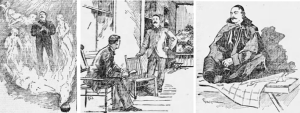
(Left) “Mr. Foulke With His Spirits At Night In The Forest Of Onset.”
(Center) “Mr. Foulke Proclaims His Messianic Mission.”[78]
(Right) Sketch of Foulke in 1894.[79]
In 1894 it was the second year of a four year economic depression known as The Panic Of 1893 (the greatest such depression the United States had yet seen.) A businessman named Jacob Coxey organized a protest march from Massillon, Ohio, to Washington D.C. It was called “The Army Of The Commonwealth In Christ,” but more popularly known as “Coxey’s Army.” At the same time, Welch invited Foulke and Falkenstein to set up a monastery for Theosophists on his property, and arrange for “Coxey’s Army” to stay there after their visit to the Capital, and “dig clams, saw wood, and do other work for a living.” It was a provocative gesture, as the cottage was near the President’s summer home. “They want to come and we cannot stop them if we would,” said Foulke. “These things work themselves. This is only the beginning of the troubles ahead which will be much worse than any we have ever passed through.”[80] The scheme, it was said, originated with guidance from the Mahatmas.[81]
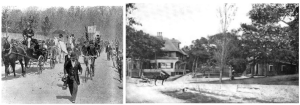
(Left) “Coxey’s Army.”[82] (Right) Summer Residence Of Edgar Welch, Onset Bay.[83]
His first enlightenment in regard to the “peculiar methods at Onset Bay,” came in 1894, when he was asked to “help out” a celebrated female medium. This he did, and other mediums as well, learning all the tricks they used to deceive people. “The only true believers in materializations are those who are willing to be deceived,” Foulke would say, and female mediums went into the business “simply to look for a chance of making a rich marriage or obtaining influence over a wealthy man.”[84] Though Foulke assisted, he was vocal in his opposition to the established Spiritualists, who were divided in opinion on Foulke. “There are people in the beautiful Onset,” said one critic, “who worship the ground [Foulke] treads on. Intellectual women are talking of him as if he were a god, although you rarely see him with a woman.”[85]
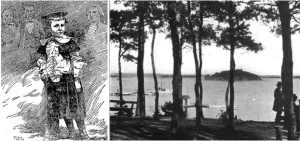
“Judson Lester Brown, Boy Theosophist.”[86] (Right) “Onset Bay From The Bluff.”[87]
One of Foulke’s plans in connection with the new movement was to open a sanitarium with accommodations for 300 patients.[88] In 1896 he also created a boys and girls’ club, with boys ranging from 13 to 16 years of age, and the girls were both 12. In this club, Foulke was made king, and one of the little girls played the role of queen.[89] There was also five-year-old Judson Lester Brown, who arrived in Onset in 1894, and lived within view of Gray Gables. The Onset Theosophists claimed that he had a mystical parentage. In the beginning, they said, a spiritual union was ordained by the shades between the boy’s mother, Miss Lester, and the radical Spiritualist, Ed Wheeler.[90] After Wheeler died in 1883, Lester married Mr. Brown, and Judson was their offspring (as the shades ordained.) Mr. Brown went to Europe, while Mrs. Brown went to Washington, D.C., where she won fame as a psychic reader, we a particular skill at detecting counterfeit money through the aid of spirits whose bidding she followed. Judson was sent to Onset to develop under the care of his grandmother, and the community came to believe that he was the reincarnation of Ed Wheeler. (This was communicated to the Onset Theosophists in 1895.) Judson claimed to “see things,” and have visions and communications with other worlds ever since he was born. The adults believed he would be a spiritual leader for the community (and the world) in the future. His “controls” in the spirit world were George Washington, Abraham Lincoln, and followers believed their guidance was preparing him for greatness. “In spite of being a good and devout Theosophist,” it was said, “Judson [was] very profane. Good judges, able to appreciate the fine points of strong and expressive rhetoric [agreed] that the little chap [could] swear faster and more picturesquely than ‘Ed’ Wheeler in his most fervent exhortations.”[91] Foulke’s involvement with children was enough to raise some eyebrows, and the police began to secretly monitor his activities.
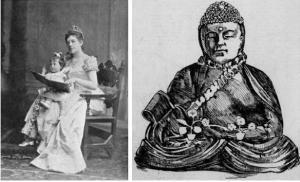
Countess Cora Di Brazza and the Contessina Ida.[92] Foulke’s Buddha Statue.[93]
W.Q. Judge died in March 1896. Katherine Tingley, Judge’s successor, launched a world-wide “Crusade” of American Theosophy. In connection with this, Burcham Harding, a lecturer for the American Theosophists, visited Onset to edge out Foulke (a perennial thorn their side.) His lecture, “What Happens After Death,” was tailor-made for the Spiritualist audience, and quite successful.[94] Foulke was getting heat from all sides. The Spiritualists did not care for him, nor did the municipal authorities (many of them Spiritualists themselves,) and Theosophists.
Around the time of the Convention of American Theosophist in April 1897, Claude Falls Wright split from the mainline Theosophical Society, taking with him a “faction of followers.” On May 1, 1897, Wright paid Foulke a visit, along with two other disaffected Theosophists, Dr. Gibier, Countess Di Brazza (Tingley’s landlord,) and Rosa Moore (Di Brazza’s secretary.)[95] It was said that the leaders of the “disrupted Aryan Branch” visited Onset Bay “for the purpose of tendering to [Foulke] the presidency of the Aryan Branch.”[96] How much truth is in that statement is debatable, however, while there, Di Brazza left a propitiatory offering of roses pedals for Foulke’s Buddha statue. A month later, Foulke found a letter near the statue which read:
Theosophists having chosen their own leaders by votes and proxies are responsible for their own failures, as can be seen in the decadent quality of their first year’s propaganda. It is only by following out the plans which we have arranged in the past, plans which originated in psychic faculties, that further and growing schisms can be avoided. You must realize that between our brotherhood and ancestors an agent must stand who can receive our instructions and transmit them to you. Otherwise you are subject to the pitfalls which arise in our human work and which our divine powers were intended to prevent in Theosophy. From time to time we have made our purposes and wishes known to you. At first, through the agency of our late brother and adept, H.P.B., but since her translation we have attempted to reach you through another leader and have been strenuously opposed by those of you who, led by selfish ambition and lack of power, desire to overthrow the very basis of your philosophy—i.e., our existence. If you desire to avoid the chasm of utter failure, and worse, in the days of retribution which are approaching, we speak to you to pause. Theosophists, unlike other secular bodies, must have a head, who holds the royal scepter of power, and this cannot be granted in your election, not imitated by pretended adepts, no matter how strongly supported they may be in your locality of hearts and minds. It is your failure to realize the fact which now makes you the subject of ridicule. You have departed from our precepts, overthrown our authority, depended upon your own faulty, human reason, which lacks psychic foresight and thus at the close of the century realize failure, schism, impotence, and regret, which you cannot avoid unless you accept again our agent who has been publicly before you since his re-election at the conference at Lansdown Road (London) in 1889. While your selection of leadership is the result of your best judgment, they are devoid of the magic power which make theosophy a divine wisdom.—Mario.[97]
Foulke was paid another visit on June 30, 1897, by a Brooklyn reporter named Clarence Crane who had arrived at Onset with his cousin, Rudolph Rhodes, around the time that Wright appeared. Crane, a “small, boyish appearing fellow, with curly hair and a slight mannerism,” was suffering from nervousness. He evidently had a reputation for being a “victim of a combination of liquor, cocaine, and hasheesh habits,” who caused trouble in Onset. Nevertheless, Foulke, believing Crane to be an emissary from the Tingley camp, welcomed him into his cottage. That night, Foulke awoke with a feeling of sickness, and went outside for some fresh air. It was then that Foulke saw Crane climbing out of his dining-room window with an object “as large a loaf of bread” under his arm. Foulke went back into his cottage, and noticed that his prized Buddha statue was missing. Foulke swore out a warrant, charging Crane with the theft, and promptly pursued Crane on his bicycle. (Crane was racing to New Bedford on horseback.) Foulke intercepted Crane in Marion, where he was arrested. The thief was released on bail in Onset, but the statue was not recovered.[98] Foulke then received an ominous letter:
Mt. Vernon Street, Boston.
July 13, 1897.
Mr. Henry Foulke, Onset Bay, Ma.
Dear Sir—Being associated as you claim to be, you no doubt in yourself feel quite pleased and honored to think that you are The Only, and that nothing but success can be yours. I would say to you, Mr. Foulke, don’t build your castles too high in the air, as there are ore yet to be raised of a more substantial foundation. You are nothing but a crank, and owe the people and apology for your bluff actions. Regarding brother Crane, would say that he is not alone, so don’t for a minute think that you have him cornered. Don’t get discouraged Mr. Foulke, as there will yet be a Buddha jubilee in Onset.
Yours,
A Follower.[99]
At the end of summer 1897, Foulke’s former acquaintance, Diss Debar, appeared unexpectedly in Onset. After being released from Blackwells Island in 1889, she pretended to commit suicide on a Jersey City ferry boat, and for a while disappeared from the public eye. She reappeared as a teacher of the occult which she claimed to have studied in India “in the bowels of the earth with a Pythagorean brotherhood.” She failed to pay her bills in room and board in Brooklyn, and earned some money playing the part of Cupid in a comic opera in Harlem, but this elicited a roar of laughter from the audience “which so wounded her vanity that she left the stage in tears.” She then claimed to be possessed by the spirit of Blavatsky, but this failed to pay, so she disappeared again. Four months later she was found in a dazed state in Cincinnati going under the name Vera P. Ava, and claiming to have been kidnapped by “clerical enemies” from Chicago. She was subsequently thrown in jail in Geneva, Illinois on charges of swindling a man out of $375 by use of spiritualistic slates. She served a sentence for similar crimes in New York, and in Rome, Italy. In 1894, she married a real estate speculator from Kentucky named William J. McGowan (whom she “victimized” like Marsh.) She then obtained a diploma from the American Theosophists under the alias of Iva Diva Veedya on June 19th, 1896. In January 1897, Diss Debar’s husband died in Chicago, where she was going by the name “Dr. Gilbert.”[100] In April she arrived in Milwaukee, Wisconsin, where she intended on opening a massage parlor. The local Branch of the Theosophical Society recognized and exposed her. They demanded that she leave town, but she protested on the grounds that she had no money. The Milwaukee Branch happily paid for her fare to be rid of her. Word was sent out to other Branches that her admittance into the Theosophical Society “was obtained under false pretenses, and for other weighty reasons,” notice was given that said diploma was cancelled.[101] She made to Boston, where she lived in a rented room on Columbus Avenue. She integrated without notice until August 1897, when a Sunday paper exposed her location. She left Boston immediately, telling her landlord that she was going to New York. This was a ruse. In reality she had gone to Onset to team up with Foulke.[102]
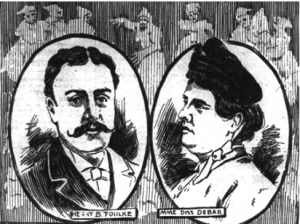
Henry B. Foulke & Diss Debar.[103]
By the autumn of 1897, Diss Debar’s cottage was fitted-up as the headquarters for Foulke’s Onset Theosophists. The rooms, which doubled as an art gallery, with spirit-paintings adorning walls with apple-green velour drapery. It was attracting some notable people, such as Rosa Moore who joined their group in late October 1897.[104] Diss Debar believed that the group would become the dominant movement of Onset, and publicly taunted the Spiritualists of Onset.[105] “I had thrown the gauntlet squarely into the face of fraud as practiced in the name of Spiritualism and psychic truth at Onset,” she boasted.[106] This provocation resulted in retaliation from the Spiritualists.
On Halloween Night 1897 Diss Debar learned that Foulke was going to be arrested on the same charges “which sent Oscar Wilde to prison,” and “a series of crimes such as has never attached to anyone in [Massachusetts,]” were said to have occurred in a room above a store used as a bicycle repair shop.[107] It was the “most heinous crime known among men,” Olcott would write.[108] If convicted of the crime of pederasty, Foulke faced a lifetime sentence.[109] Whether or not Foulke’s accusers truly believed he was guilty of the act remains unclear. There seemed to be a belief that there was a “nest of [such] criminals […] menacing society,” and that Foulke was not alone under suspicion. The Banner Of Light stated:
There are others in Boston and vicinity under espionage, and it will be surprising if further revelations are not made to the public upon this subject. It is now time to act in this matter, and to demand punishment and restraint for this especial class of malefactors. Crimes against nature of a nameless order are not pleasant things to contemplate, but they cannot be removed by closing our eyes to them, nor by refusing to hear the painful accounts of them. The Upas-tree can be dug up from the root, and the offenders placed under restraint.[110]
While discussing the matter of his arrest in her cottage, Diss Debar urged Foulke to escape. Foulke decided to remain
“Dear madame,” said Foulke, “they have threatened me and talked of this uncanny thing for the past three years. Do not attach any importance to any such statements made regarding this crime and myself, I assure you that it cannot be sustained.”
“I know that the officers had been in Onset overnight,” said Diss Debar.
“If it is just as you say,” Foulke replied, “I would still wish to be arrested, because this charge must come to an issue.”
Two hours later Crane appeared at Diss Debar’s door. He told Foulke that if he withdrew the case against him at Plymouth (which was to be held on November 4, 1897) then he would not be arrested. “They are going to arrest you on serious charges,” said Crane, “let’s call it square.”
Foulke declined, and showed Crane out the door. Thirty minutes later, officers Edward R. Smythe and Benjamin J. Loring, special agents of the Society for the Prevention of Cruelty to Children, arrested Foulke, and took him to Wareham where he was arraigned before Judge Alden on November 1. When asked for comment by the press, Officer Loring said:
Officer Smyth and myself have been spending a great deal of our time for more than a year obtaining evidence, and before we have dropped the matter a horrible state of affairs will be brought to light. We have been watching H. B. Foulke and others for a long time, but not until Sunday were we ready to place him under arrest. When we called at the house he was there with Madame Diss Debar, but had all his goods packed and in readiness to leave […] If Foulke were the only person against whom we have a grievance the case would not be so bad, but before we get through some fifty of his followers will be brought to court. We have six boys and two little girls to appear as witnesses against him, and they all belong to respectable parents.[111]
Diss Debar called on Foulke at Plymouth jail on the night of his arrest, but all attempts at securing his release had failed. She proffered all the money in her possession and all of her jewelry to several of the residents of Onset as security if they would front the $2,500 bail for Foulke, but she found nobody willing to take the risk or the odium.[112] She went again to the jail on November 2, but Foulke was not in a communicative mood.
“My dear boy,” Diss Debar told Foulke, “you have been wanting notoriety, now you’ve got it.”
“Don’t be joking me, madame,” Foulke replied sternly.[113]
Foulke remained in Plymouth jail until his trial in February 1898.[114] The case was heard by Judge Richardson, and in Olcott’s words, the “trial ended in his conviction on two counts, and the evidence proved him to have debauched and ruined many young boys, and moreover to have acted the part of a spook for more than one pretended materializing medium in Onset and Boston.”[115] A special deal was made with Foulke, who in exchange for a light sentencing, promised to expose “all the Spiritualism in Onset Bay.”[116] This condition was apparently satisfied by an article he wrote while in prison, “How I Make Ghosts In Cabinets,” which was widely-published in the newspapers in America.[117] He was released from prison, but a year later he was arrested again by Officer Loring for a similar charge (this was evidently a mix-up, as he was immediately released.)[118] This seems to have put an end to Foulke’s public career. His name never appeared again in public. He died in Preoria, Illinois, in 1938. The coroner’s report stated his occupation as “clairvoyant.”[119]
As for his Buddha statue, that mystery was solved (somewhat) in February 1900, when Countess Wachmeister arrived in Massachusetts with the statue that Crane had stolen. Nobody could account for its “missing years,” nor how she came to possess it. Wachtmeister allegedly gave it to the Wachusett Branch of the Adyar-based Theosophists, and it was subsequently placed in a shrine in Worcester, Massachusetts.[120]
SOURCES
[1] “The Second Christ.” The Philadelphia Inquirer. (Philadelphia, Pennsylvania) June 24, 1894.
[2] [Birth/Death.] “Illinois Deaths and Stillbirths, 1916-1947,” database, FamilySearch (https://familysearch.org/ark:/61903/1:1:NQQN-21V : 9 March 2018), Henry Foulke, 27 Mar 1938; Public Board of Health, Archives, Springfield; FHL microfilm 1,818,556. [Address] “Called Home By Spirits.” The Two Worlds. Vol. II, No. 74 (April 12, 1889): 258. [Membership.] Theosophical Society General Membership Register, 1875-1942 at http://tsmembers.org/. See book 1, entry 4034. (Website file: 1B:1885-1890) Henry B. Foulke.
[3] “The Second Christ.” The Philadelphia Inquirer. (Philadelphia, Pennsylvania) June 24, 1894.
[4] “Foulke Now A Prophet.” The Philadelphia Times. (Philadelphia, Pennsylvania) December 31, 1893.
[5] “Mr. Foulke’s Answer.” The Philadelphia Times. (Philadelphia, Pennsylvania) December 12, 1892.
[6] “Foulke Now A Prophet.” The Philadelphia Times. (Philadelphia, Pennsylvania) December 31, 1893.
[7] “Says He Is Messiah.” The Boston Globe. (Boston, Massachusetts) September 17, 1893.
[8] December 2, 1886, box 4, folder 10, The Wagner Free Institute of Science Robert Chambers Collection, Building Materials, 90-015, Library and Archives of the Wagner Free Institute of Science.
[9] Schmidt, Leigh Eric. Heaven’s Bride: The Unprintable Life Of Ida C. Craddock, American Mystic, Scholar, Sexologist, Martyr, and Madwoman. Basic Books. New York, New York. (2010): 48. Membership.] Theosophical Society General Membership Register, 1875-1942 at http://tsmembers.org/. See book 1, entry 9. (Website file: 1A:1875-1885) R. B Westbrook. [15 W. 42 Street, New York, New York. (11/17/1875); Membership.] Theosophical Society General Membership Register, 1875-1942 at http://tsmembers.org/. See book 1, entry 19. (Website file: 1A:1875-1885) H. P Westbrook. [15 W. 42 Street, New York, New York. (11/17/1875)
[10] “Says He Is Messiah.” The Boston Globe. (Boston, Massachusetts) September 17, 1893.
[11] “Foulke Now A Prophet.” The Philadelphia Times. (Philadelphia, Pennsylvania) December 31, 1893.
[12] “Is Foulke Insane?” The Boston Globe. (Boston, Massachusetts.) November 21, 1897.
[13] Olcott, H.S. “‘Precipitated’ Pictures At New York.” The Theosophist. Vol. IX, No. 106 (July 1888): 577-586.
[14] Callahan, James Morton. Semi-centennial History Of West Virginia. Semi-centennial Commission Of West Virginia. Morgantown, West Virginia. (1913): 591.
[15] Blodgett, W. H. “Career Of Famous Woman Crook Makes Interesting Story.” The Windsor Star. (Windsor, Ontario) August 13, 1921.
[16] The Krishna T.S., chartered in the autumn of 1886, becoming a full Branch in 1887 with Carl F. Redwitz. As President, Edward H. Sanborn as Secretary, and Swaim Stewart as Treasurer. Redwitz went to New Orleans. [Theosophical Society General Membership Register, 1875-1942 at http://tsmembers.org/. See book 1, entry 3567. (Website file: 1B:1885-1890) Carl F. Redwitz. (1/14/1886); Theosophical Society General Membership Register, 1875-1942 at http://tsmembers.org/. See book 1, entry 3949. (Website file: 1B:1885-1890) Swaim Stewart. (4/21/1887); Theosophical Society General Membership Register, 1875-1942 at http://tsmembers.org/. See book 1, entry 3950. (Website file: 1B:1885-1890) Edward H. Sanborn. (4/21/1887); “Theosophical Activities.” The Path. Vol. I, No. 7 (October 1886): 223-224; “Literary And Theosophical Notes.” The Path. Vol II., No. 3. (June 1887): 93-95; “Theosophical Activities.” The Path. Vol. V, No. 4 (July 1890): 130-139.]
[17] “Theosophical Activities.” The Path. Vol. III., No. 2. (May 1888): 65-66; “Dr. Eddy in Town.” The Philadelphia Times. (Philadelphia, Pennsylvania) October 14, 1888; “Gotham Gossip.” The Daily Picayune. (New Orleans, Louisiana) November 16, 1888; “To Seek Buddha’s Grave.” The Philadelphia Times. (Philadelphia, Pennsylvania) January 16, 1889; “Theosophical Activities.” The Path. Vol. III., No. 9. (December 1888): 298-300; “The Late Govinda Row Sattay.” Supplement To The Theosophist. (February 1889): xli.
[18] D. Appleton and Company. Appletons’ Annual Cyclopædia and Register of Important Events of the Year 1892. D. Appleton and Company. New York, New York. (1893): 547.
[19] “Sudden Death of Kate Fox.” The Philadelphia Inquirer. (Philadelphia, Pennsylvania) July 4, 1892.
[20] Though his name is not attached to the article, it would seem as though Stead was the author of “The Haunted House In Cheyne-Row,” in the September 10, 1888 issue of The Pall Mall Gazette. [“The Haunted House In Cheyne-Row.” The Pall Mall Gazette. (London, England) September 10, 1888.] There are several clues within the text that suggest this. The article is a synopsis of a séance at Carlyle’s old home, hosted by a woman named Cottell. [James William Cottell. [Ancestry.com. India, Select Births and Baptisms, 1786-1947 [database on-line]. Provo, UT, USA: Ancestry.com Operations, Inc., 2014.] During the sitting, the alleged spirit of Benjamin Disraeli communicated with Stead. Stead writes: “The juxtaposition of Benjamin Disraeli and Thomas Carlyle! I remember well coming into this room when Mr. Carlyle was living. It was during the Afghan War, and I remarked that things were not looking well, when Mr. Carlyle, turning round, remarked with vehemence, ‘And they will never look any better, sir, unless it please the heavenly, or the infernal, power to take away this damnable Jew, a man who has brought more shame and disgrace upon this country than any other man in the whole course of her history.’” [“The Haunted House In Cheyne-Row.” The Pall Mall Gazette. (London, England) September 10, 1888.] Compare this statement with Stead’s writing about Carlyle: “[Carlyle said:] The Turk has lain there for four centuries and more without doing a single good thing for the world or for the lands he laid himself down upon. He has never been anything but a destroyer from first to last. The only good thing he ever did was to destroy the Lower Empire, They were a bad lot of men, those Greeks, not much better than the Turks, with their lawyer-like intellects, wrangling and discussing over subtleties and forms of words and forgetting their duties until the Turk came and swept them away. Since then, he has simply been a curse and a scourge to the lands he overran. And now his hour has come. It is sheer downright Bedlamism for Lord Beaconsfield or anyone else to try to save the Turk. To drag this country into arms against Russia is the damnablest course ever suggested to the English nation in the whole course of history. And to save the Turk! Sir, the Turk is on the verge of Hell and no one but God Almighty can save him now.” [Whyte, Frederic. The Life of W.T. Stead. Vol. I. Jonathan Cape Limited. London, England. (1925): 58-59.]]
[21] The Theosophist, Edmund Russell, was also present. “It was in Thomas Carlyle’s house I heard my first ‘spirit rappings.’ My portrait was being painted by the artist who used as a studio that little retreat with no windows the sage of Cheyne-Chelsea had built for himself on top of the house. I stopped on to dinner. One of the celebrated ‘Fox Sisters’ was visiting the old lady of cats and emeralds who then occupied, and in the evening, there was a séance. I don’t remember that the spirit of Thomas Carlyle appeared to remonstrate at this desecration, but Charlotte Cushman told me she always protected me. It was all very unconvincing, though the raps were extraordinary. The next morning I happened to be with Blavatsky at breakfast time and told her I had heard strange things the night before.” [Russell, Edmund. “The Secret Doctrine: Personal Recollections Of Madame Blavatsky.” The Occult Review. Vol. XXXI, No. 6. (June 1920): 332-340; Theosophical Society General Membership Register, 1875-1942 at http://tsmembers.org/. See book 1, entry 4672. (website file: 1B: 1885-1890) Edmund Russell. (Joined 11/12/88). [Edmund Russell, 10 Chepstow Place, Pembridge Square, joined Blavatsky Lodge.]
[22] “The Haunted House In Cheyne-Row.” The Pall Mall Gazette. (London, England) September 10, 1888; “The Mails.” The London Evening Standard. (London, England) September 29, 1888.
[23] “Jottings.” The Boston Evening Transcript. (Boston, Massachusetts) October 1, 1888; “Katy Fox.” The Catholic Union and Times. (Buffalo, New York) October 18, 1888.
[24] “Gotham Gossip.” The Daily Picayune. (New Orleans, Louisiana) October 17, 1888.
[25] When the New York press asked Katie about the séances she held in London, she said: “All that took place there of that nature is utterly false. I haven t the slightest idea that the noises which we heard in the house had any connection with Carlyle’s spirit. I certainly know that every so-called manifestation produced through me in London or anywhere else was a fraud. Many a time have I wept because when I was young and innocent, I was brought into such a life. The time has now come for Maggie, and I set ourselves right before the world. Nobody knows at what moment either of us might be taken away. We ought not to leave this base fabric of deceit behind us unexposed.” [Davenport, Reuben Briggs. The Deathblow to Spiritualism. G.W. Dillingham. New York, New York. (1888): 58-59.] It would seem, however, that she secretly still believed in Spiritualism. On November 17, 1888, Katie Fox (Jencken) wrote a letter to E.A. Cottell stating: “I would have written to you before this, but my surprise was so great on my arrival to hear of Maggie’s exposure of Spiritualism that I had no heart to write to anyone. The manager of the affair engaged the Academy of Music, the very largest place of entertainment in New York City; it was filled to over-flowing. They made 1,500 dollars clear. I have often wished I had remained with you, and if I had the means I would now return, to get out of all this. I think now I could make money in proving that the knockings are not made with the toes. So many people come to me to ask me about this exposure of Maggie’s that I have to deny myself to them. They are bard at work to expose the whole thing if they can; but they certainly cannot. Maggie is giving public exposures in all the large places in America, but I have only seen her once since I arrived.” [“The Foxes and Their Foxing.” Light. Vol. VIII, No. 415 (December 15, 1888): 619.]
[26] “Did Somebody Try To Abduct Them?” The Sun. (New York, New York) October 16, 1888.
[27] Olcott, Henry Steel. People From the Other World. American Publishing Company. Hartford, Connecticut. (1875): 293; “Dr. Eddy in Town.” The Philadelphia Times. (Philadelphia, Pennsylvania) October 14, 1888.]
[28] “About Town.” The Rutland Daily Herald. (Rutland, Vermont.) November 30, 1881.
[29] “Marriages.” The Rural Vermonter. (Montpelier, Vermont.) October 1, 1886; “Notice.” The Rutland Weekly Herald and Globe. (Rutland, Vermont.) May 19, 1887.
[30] “Dr. Eddy in Town.” The Philadelphia Times. (Philadelphia, Pennsylvania) October 14, 1888.
[31] Moore, William D. “‘To Hold Communion with Nature and the Spirit-World’: New England’s Spiritualist Camp Meetings, 1865-1910.” Perspectives In Vernacular Architecture. Vol. VII (1997): 230–248.
[32] “Spirits in Camp.” The Sun. (New York, New York) August 26, 1888.
[33] “Called Home By Spirits.” The Two Worlds. Vol. II, No. 74 (April 12, 1889): 258.
[34] “Gotham Gossip.” The Daily Picayune. (New Orleans, Louisiana) November 16, 1888; “The Late Govinda Row Sattay.” Supplement To The Theosophist. (February 1889): xli.
[35] “Shade of Sattay.” The Independent Record. (Helena, Montana) November 22, 1888.
[36] “Diss De Bar Defends Him.” The Journal. (Meriden, Connecticut) November 5, 1897.
[37] “Called Home By Spirits.” The Two Worlds. Vol. II, No. 74 (April 12, 1889): 258.
[38] “Suicide Of A Young ‘Plunger.’” The Evening Star. (Washington, D.C.) April 19, 1893.
[39] “To Seek Buddha’s Grave.” The Philadelphia Times. (Philadelphia, Pennsylvania) January 16, 1889.
[40] “Foulkes Claims Ridiculed.” The Philadelphia Times. (Philadelphia, Pennsylvania) November 25, 1892.
[41] “Supernatural Power Attributed To An Idol.” The Philadelphia Inquirer. (Philadelphia, Pennsylvania) July 11, 1897.
[42] “Foulkes Claims Ridiculed.” The Philadelphia Times. (Philadelphia, Pennsylvania) November 25, 1892.
[43] “This Morning’s News.” The Boston Evening Transcript. (Boston, Massachusetts) January 8, 1889; “News Of The Week.” The Weekly Clarion. (Cherryvale, Kansas) January 10, 1889.
[44] “Is Foulke Insane?” The Boston Globe. (Boston, Massachusetts.) November 21, 1897.
[45] “Suicide Of A Young ‘Plunger.’” The Evening Star. (Washington, D.C.) April 19, 1893.
[46] “Theosophical Activities.” The Path. Vol. III, No. 11 (February 1889): 361-364.
[47] In August 1887 Blavatsky arranged for the publisher George Redway to solicit subscriptions for Lucifer for a period of twelve months, and print and publish that magazine in his name. Redway accordingly made out his account each month, crediting the Theosophical Publishing Company Limited (TPC) with the gross amount received from all subscribers. In June 1888 the (TPC) started a book concern at Duke Street, Adelphi, and took Lucifer out of Redway’s hands. The (TPC,) however, did not refund Redway the sums he had paid them, on account of his subscribers, for the numbers that were not yet published. In July 1888, Redway refunded 300 subscribers the balance of their subscriptions since he could no longer provide them Lucifer. He did this with the expectation that he would recover the amount from (TPC.) The (TPC) resisted, however, claiming that Redway, their agent, had acted unilaterally, and that how they distributed refunds was ultimately their decision to make. The matter went to court, and the case between the (TPC) and Redway in reference to Lucifer were tried together at the Westminster County Court on February 25, 1889. (Ashton Ellis, Bertram Keightley, Archibald Keightley, and Mabel Collins, were among the witnesses who testified on behalf of the Theosophists. The court ruled in favor of Redway, however, and the (TPC) was ordered to pay him a certain sum. [“Theosophy.” The Publishers’ Circular. Vol. LII, No. 1,235. (March 1, 1889): 215.]
[48] “Mr. Foulke’s Answer.” The Philadelphia Times. (Philadelphia, Pennsylvania) December 12, 1892.
[49] “We are glad to announce that Madame Blavatsky, who has recently been suffering from severe nervous prostration and therefore obliged for a time to abandon all literary work, is greatly improved. She was taken to Brighton ,where sunny rooms, overlooking the sea, had been engaged for her, and has rallied under these influences. Itis certainly doubtful whether the London climate is suitable for her, and the occasional rumors of a return to America, which flit through the correspondence and speech of Theosophists, may perhaps have life in them. What an era it would be for the American Section if this came to pass! But we adhere strictly to speculation, not venturing upon prophecy.” [“Theosophical Activities.” The Path. Vol. IV, No. 12 (March 1890): 384-389.]
[50] “Foulkes Claims Ridiculed.” The Philadelphia Times. (Philadelphia, Pennsylvania) November 25, 1892.
[51] “Col. S. P. Kase As Spiritualist.” The Lewisburg Chronicle. (Lewisburg, Pennsylvania) August 21, 1879; “Simon P. Kase Died In Philadelphia.” The Danville News. (Danville, Pennsylvania) August 28, 1900.
[52] “Called Home By Spirits.” The Two Worlds. Vol. II, No. 74 (April 12, 1889): 258.
[53] Theosophical Society General Membership Register, 1875-1942 at http://tsmembers.org/. See book 1, entry 6249. (Website file: 1B:1885-1890) Ferdinand Falkenstein. [Deutsche T.S. 2241 West Tenth Street. Philadelphia, Pennsylvania. (10/25/1890); Theosophical Society General Membership Register, 1875-1942 at http://tsmembers.org/. See book 1, entry 6250. (Website file: 1B:1885-1890) Charles Falkenstein. [Deutsche T.S. 2241 West Tenth Street. Philadelphia, Pennsylvania. (10/25/1890); Theosophical Society General Membership Register, 1875-1942 at http://tsmembers.org/. See book 1, entry 6251. (Website file: 1B:1885-1890) Marie Cloeren. [Deutsche T.S. 2241 West Tenth Street. Philadelphia, Pennsylvania. (10/25/1890.)
[54] “Theosophical Activities.” The Path. Vol. V, No. 9 (December 1890): 293-296.
[55] “Mr. Foulke’s Answer.” The Philadelphia Times. (Philadelphia, Pennsylvania) December 12, 1892.
[56] “Resignation Of Presidency T.S. By Col. Olcott.” The Path. Vol. VI, No. 12 (March 1892): 406-407.
[57] “Foulke Now Leads.” The Philadelphia Times. (Philadelphia, Pennsylvania) February 3, 1892.
[58] “The Humble Nazarene.” The Banner Of Light. Vol. LXIX, No. 25 (August 20, 1891): 4.
[59] Hartmann writes: “[Foulke] receives oil paintings that have been undoubtedly produced in an occult manner through the mediumship of [Beste]; they are well executed but they never are what they claim to be, for there is one representing the ‘wife of Pythagoras,’ who presumably never was married, another represents ‘Jacob Boehme in his college costume’ while it is certain that Boehme was a poor shoemaker, who never went to a college; there are ‘Mahatma letters’ that are perfectly ‘genuine,’ except in so far as they have never been written or even indicated by a Mahatma; there are innumerable tests spirit identity, absolutely satisfactory to a superficial observer, but found to be sadly wanting in truth, when closely examined. In most instances it seems as if a host of lying spirits were assuming the true masks known persons; the acting is often perfect, but the actor behind the mask is not what he represents himself to be, although many a deluded person, being delighted with the idea of communicating with a beloved friend or relative, is most unwilling to incur the risk finding himself deceived. Whenever the communicating spirit represents himself in the garb of a spirit-lover or spirit-bride, human vanity becomes excited to the highest pitch, and a cure is almost impossible. Such persons regard doubts about the identity of their ‘spirits’ as being blasphemy and heresy of the worst kind.” [Hartmann, Franz. “Vampires.” Borderland. Vol. III, No. 3 (July 1896): 353-356.]
[60] “Foulke Now Leads.” The Philadelphia Times. (Philadelphia, Pennsylvania) February 3, 1892.
[61] “Foulke Now Leads.” The Philadelphia Times. (Philadelphia, Pennsylvania) February 3, 1892.
[62] Theosophical Society, American Section Sixth Annual Convention Held At Palmer House, Chicago, April 24th and 25th, 1892.
[63] The Theosophical Movement: 1875-1925. E.P. Dutton & Company. New York, New York. (1925): 364.
[64] Judge writes: “[Letter 1]: Will you permit me to correct the statement […] that Madame Blavatsky appointed as her ‘successor’ Mr. Henry B. Foulke, and “guaranteed” to him the ‘allegiance’ of the ‘higher spiritual intelligences and forces.’ As one of Madame Blavatsky’s oldest and most intimate friends, connected with her most closely in the foundation and work of the Theosophical Society, and familiar with her teachings, purposes, ideas, forecasts, I am in a position to assure […] the public that there is not an atom of foundation for the statement quoted. Madame Blavatsky has no ‘successor,’ could have none, never contemplated, selected, or notified one. Her work and status were unique. Whether or not her genuineness as a spiritual teacher be admitted matters not: she believed it to be so, and all who enjoyed her confidence will unite with me in the assertion that she never even hinted at ‘succession,’ ‘allegiance,’ or ‘guarantee.’ Even if a successor was possible, Mr. Foulke could not be he. He is not a member of the Theosophical Society, does not accept its and her teachings, had a very slight and brief acquaintance with her, and pretends to no interest in her views, life or mission. Of her actual estimate of him I have ample knowledge. But anyhow, no ‘guaranteeing of allegiance of spiritual forces’ is practicable by anyone. Knowledge of and control over the higher potencies in Nature comes only by individual attainment through long discipline and conquest. It can no more be transferred than can a knowledge of Greek, of chemistry, psychology, or of medicine. If a person moves on a lofty level, it is because he worked his way there. This is true in spiritual things as in mental. When Mr. Foulke produces a work like Isis Unveiled or The Secret Doctrine, he may be cited as H.P.B.’s intellectual peer; when he imparts such impulsion as does The Voice Of The Silence, he may be recognized as her spiritual equal; when he adds to these an utter consecration to the work of the T.S. as his lifelong mission, he may participate in such “succession” as the case admits. But it will not be through alleged precipitated pictures and imagined astral shapes. The effect of these on Theosophy […] may be stated in one word—nothing. [Letter 2]: Will you allow me a word—my last—respecting the Foulke claim to succeed Mme. Blavatsky. First. If Mr. Foulke […] has precipitated pictures of Mme. Blavatsky produced since her demise… Precipitations are not uncommon, but are no evidence of anything whatever save the power to precipitate and the fact of precipitation. Spiritualists have always asserted that their mediums could procure these things. Chemists also can precipitate substances out of the air. So this point is wide of the Society and its work. Second. As I said in my previous letter, when Mr. Foulke, or any one, indeed, proves by his work and attainments that he is as great as Mme. Blavatsky, everyone will at once recognize that fact. But irresponsible mediumship, or what we call astral intoxication, will not prove these attainments nor constitute that work. Third. Mme. Blavatsky was Corresponding Secretary of the Theosophical Society, and its Constitution years ago provided that office, out of compliment to her, should become extinct upon her death […] The Society will hardly hurry to revive it for the sake of one who is not a member of the body and who has never thrown any particular glory upon it. Scarcely either because he is a medium—and not even a good one—who prates of receiving messages from beyond the grave assumed to be from Mme. Blavatsky. He may assert that he has baskets full of letters from Mme. Blavatsky written before her death, and we are not interested either to deny the assertion or to desire to see the documents. Fourth. The Theosophical Society is a body governed by Rules embodied in its Constitution. Its officers are elected by votes, and not by the production of precipitated letters or pictures of any sort. It generally elects those who do its work, and not outsiders who masquerade as recipients of directions from the abode of departed souls. It is not likely to request proposed officers to produce documents… brought forth at mediumistic seances before the wondering eyes of untrained witnesses […] Fifth. Mr. Foulke’s possession of any number of letters written by Mme. Blavatsky prior to her demise, offering him ‘leadership’ or ‘succession,’ might please and interest himself, but can have no other effect on the corporate body of the Society. Let him preserve them or otherwise as he may see fit; they are utterly without bearing or even authority, and if in existence would only serve to show that she in her lifetime may have given him a chance to do earnest sincere work for a Society she had at heart and that he neglected the opportunity, passing his time in idle, fantastic day-dreams.” [“Theosophical Activities.” Lucifer. Vol. X, No. 55 (March 15, 1892): 78-83.]
[65] In the Supplement To The Theosophist for April 1892, Olcott states: “A rubbishing report is circulating to the effect that H.P.B. chose Mr. Foulke of Philadelphia, as her ‘Successor,’ and ratified her act by appearing in a spiritualistic circle and painting for him her portrait. As to the picture having been painted I say nothing save that it is no more improbable than other portrait paintings in mediumistic circles: but this does not imply that she painted it. And to offset that theory one has but to refer back to an old volume of The Theosophist to find that she and I, anticipating some such nonsense, published our joint declaration that under no circumstances should we visit after death a medium or a circle, and authorizing our friends to declare false any story to the contrary. As for her naming a ‘Successor,’ Beethoven or Edison, Magliabeechi or Milton might just as well declare A, B or C the heirs of their genius. Blavatsky nascitur, non fit.” [The Theosophical Movement: 1875-1925. E.P. Dutton & Company. New York, New York. (1925): 367-368.]
[66] Judge, W.Q. “How She Must Laugh.” The Path. Vol. VII, No. 4 (July 1892): 101-102.
[67] Olcott, H.S. “Old Diary Leaves: The Meeting Of H.P.B. And Myself.” The Theosophist. Vol. XIII, No. 6 (March 1892): 323-336.
[68] “Mirror Of The Movement.” The Path. Vol. VII, No. 7 (October 1892): 231-236.
[69] “Mr. Foulke’s Answer.” The Philadelphia Times. (Philadelphia, Pennsylvania) December 12, 1892.
[70] Besant, Annie. “On The Watch-Tower.” Lucifer. Vol. X, No. 57 (May 15, 1892): 177-184.
[71] “Foulkes Claims Ridiculed.” The Philadelphia Times. (Philadelphia, Pennsylvania) November 25, 1892.
[72] “Foulke Now A Prophet.” The Philadelphia Times. (Philadelphia, Pennsylvania) December 31, 1893.
[73] “The Second Christ.” The Philadelphia Inquirer. (Philadelphia, Pennsylvania) June 24, 1894.
[74] “Mahatma’s At Odds.” The Philadelphia Times. (Philadelphia, Pennsylvania) October 31, 1892.
[75] “Mahatma’s At Odds.” The Philadelphia Times. (Philadelphia, Pennsylvania) October 31, 1892.
[76] “Suicide Of A Young ‘Plunger.’” The Evening Star. (Washington, D.C.) April 19, 1893.
[77] “Says He Is Messiah.” The Boston Globe. (Boston, Massachusetts) September 17, 1893.
[78] “Says He Is Messiah.” The Boston Globe. (Boston, Massachusetts) September 17, 1893.
[79] “Foulke’s Loaves And Fishes.” The Boston Globe. (Boston, Massachusetts) June 24, 1894.
[80] “Coxey’s Army.” The Fall River Globe. (Fall River, Massachusetts) June 22, 1894.
[81] “Foulke’s Loaves And Fishes.” The Boston Globe. (Boston, Massachusetts) June 24, 1894.
[82] Public Domain.
[83] Perry, E.G. A Trip Around Buzzards Bays Shores. E.G. Perry. Monument Beach. Massachusetts. (1903): 146.
[84] Foulke, Henry B. “How I Make Ghosts In Cabinets.” The San Francisco Examiner. (San Francisco, California) April 17, 1898.
[85] “The Heir Of Blavatsky.” The Sun. (New York, New York) September 7, 1893.
[86] “Small Boy Theosophist.” The World. (New York, New York) May 17, 1896.
[87] Gilbert, Russ H. The Story Of A Wigwam. Mary C. Weston. Onset, Massachusetts. (1904): 11.
[88] “On Serious Charge.” The Boston Globe. (Boston, Massachusetts) November 2, 1897.
[89] “On Serious Charge.” The Boston Globe. (Boston, Massachusetts) November 2, 1897.
[90] “The Death Of E.S. Wheeler.” The New York Times. (New York, New York) November 17, 1883.
[91] “Small Boy Theosophist.” The World. (New York, New York) May 17, 1896.
[92] Slocomb, Cora (Countess Di Brazza.) A Guide To Old And New Lace In Italy, Exhibited At Chicago In 1893. W.B. Conkey Company. Chicago, Illinois. (1893): 4.
[93] “Supernatural Power Attributed To An Idol.” The Philadelphia Inquirer. (Philadelphia, Pennsylvania) July 11, 1897.
[94] “New Teacher.” The Boston Post. (Boston, Massachusetts) June 10, 1896.
[95] Theosophical Society General Membership Register, 1875-1942 at http://tsmembers.org/. See book 1, entry 4453. (website file: 1B: 1885-1890) Rosa Moore. (5/15/1888); “Theosophists At Onset.” The Fall River Globe. (Fall River, Massachusetts) May 3, 1897; “Miss Moore At Onset Bay.” The Times Leader. (Wilkes-Barre, Pennsylvania) October 28, 1897.
[96] “Theosophists At Onset.” The Fall River Globe. (Fall River, Massachusetts) May 3, 1897; “Got A Precipitated Message.” The Sun. (New York, New York) May 25, 1897
[97] “Supernatural Power Attributed To An Idol.” The Philadelphia Inquirer. (Philadelphia, Pennsylvania) July 11, 1897.
[98] “Search Warrant For Buddha.” The Philadelphia Inquirer. (Philadelphia, Pennsylvania) July 4, 1897; “Crane Guilty.” The Boston Globe. (Boston, Massachusetts) July 15, 1897.
[99] “Foulke Gets An Anonymous Letter.” The Boston Globe. (Boston, Massachusetts) July 14, 1897.
[100] Diss Debar’s Husband Dying. The New York Times. (New York, New York) January 25, 1897; Hargrove, E. T. “A Warning.” The Theosophical Forum. Vol. III, No. 1 (May 1897): 15.
[101] “Asked To Leave Town.” The Boston Globe. (Boston, Massachusetts) May 6, 1897; Hargrove, E. T. “A Warning.” The Theosophical Forum. Vol. III, No. 1 (May 1897): 15.
[102] “Diss Debar In Boston?” The Sun. (New York, New York) August 25, 1897; Blodgett, W. H. “Career Of Famous Woman Crook Makes Interesting Story.” The Windsor Star. (Windsor, Ontario) August 13, 1921.
[103] “Henry B. Foulke And Mme. Diss Debar. Whose New Theosophical Cult Has Developed A Scandal.” The San Francisco Chronicle. (San Francisco, California) November 3, 1897.
[104] “Miss Moore At Onset Bay.” The Times Leader. (Wilkes-Barre, Pennsylvania) October 28, 1897.
[105] “Activity Among Theosophists.” The Boston Evening Transcript. (Boston, Massachusetts) October 26, 1897.
[106] “Diss De Bar Defends Him.” The Journal. (Meriden, Connecticut) November 5, 1897.
[107] “On Serious Charge.” The Boston Globe. (Boston, Massachusetts) November 2, 1897.
[108] “Cuttings And Comments.” The Theosophist. Vol. XIX, No. 10 (July 1898): 571-576.
[109] “On Serious Charge.” The Boston Globe. (Boston, Massachusetts) November 2, 1897.
[110] “A Good Move.” The Banner Of Light. Vol. LXXXII, No. 11 (November 13, 1897): 4.
[111] “On Serious Charge.” The Boston Globe. (Boston, Massachusetts) November 2, 1897.
[112] “Diss De Bar Defends Him.” The Journal. (Meriden, Connecticut) November 5, 1897.
[113] “On Serious Charge.” The Boston Globe. (Boston, Massachusetts) November 2, 1897.
[114] “A Good Move.” The Banner Of Light. Vol. LXXXII, No. 11 (November 13, 1897): 4.
[115] “Cuttings And Comments.” The Theosophist. Vol. XIX, No. 10 (July 1898): 571-576.
[116] “Guilty On Two Counts.” The Boston Globe. (Boston, Massachusetts) February 26, 1898.
[117] Foulke, Henry B. “How I Make Ghosts In Cabinets.” The San Francisco Examiner. (San Francisco, California) April 17, 1898.
[118] “Foulke Again Arrested.” The Fall River Globe. (Fall River, Massachusetts) January 5, 1899; “News In Brief.” The Cambridge Transcript. (Cambridge, Vermont) March 10, 1899.
[119] [Birth/Death.] “Illinois Deaths and Stillbirths, 1916-1947,” database, FamilySearch (https://familysearch.org/ark:/61903/1:1:NQQN-21V : 9 March 2018), Henry Foulke, 27 Mar 1938; Public Board of Health, Archives, Springfield; FHL microfilm 1,818,556. [Address] “Called Home By Spirits.” The Two Worlds. Vol. II, No. 74 (April 12, 1889): 258. [Membership.] Theosophical Society General Membership Register, 1875-1942 at http://tsmembers.org/. See book 1, entry 4034. (Website file: 1B:1885-1890) Henry B. Foulke.
[120] “American Branches.” Supplement To The Theosophist. (March 1898) xxii; “Buddha To Be Restored.” The Fall River Globe. (Fall River, Massachusetts) January 30, 1899.


